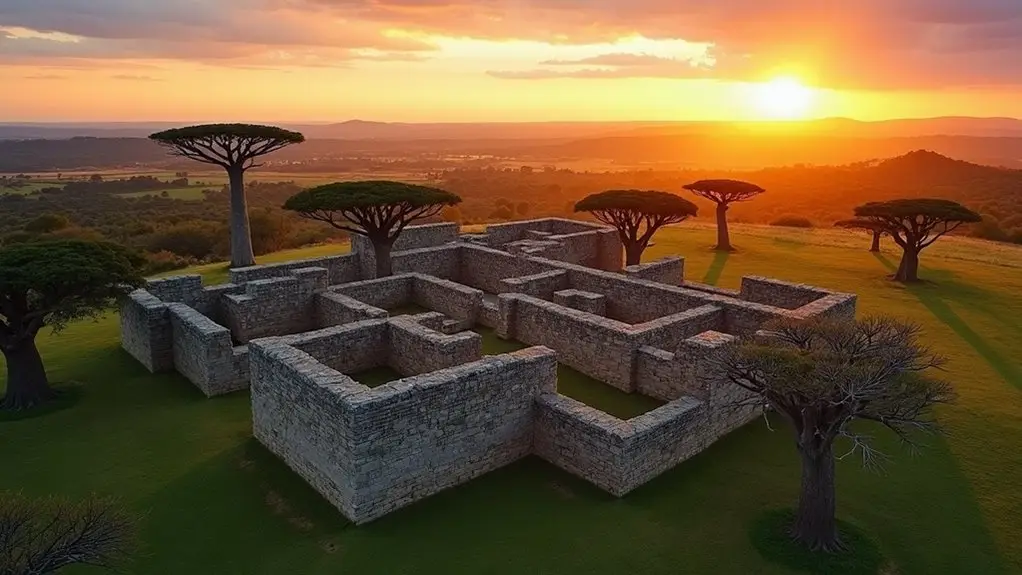When you think about Africa's rich heritage, several historical sites come to mind, each telling a unique story of the continent's past. From the Great Pyramids of Giza, which stand as a symbol to ancient engineering, to the scholarly legacy of Timbuktu, these locations offer a glimpse into the diverse civilizations that have shaped Africa. You might be surprised by the depth of history hidden in places like Olduvai Gorge or the architectural wonders of Great Zimbabwe. What's more, there are even lesser-known sites that could challenge your understanding of Africa's heritage.
Key Takeaways
- Olduvai Gorge: A UNESCO World Heritage Site in Tanzania, it offers invaluable insights into human evolution with significant hominin fossil discoveries.
- Thebes: The heart of ancient Egypt, featuring monumental sites like the Karnak Temple and the Valley of the Kings, showcasing rich historical layers.
- Great Pyramids of Giza: Iconic tombs reflecting ancient Egyptian architectural skills, these are the last of the Seven Wonders of the Ancient World.
- Meroe: Known for its unique pyramids and iron production, this UNESCO World Heritage Site highlights the cultural significance of the Kingdom of Kush.
- Timbuktu: A vital trading post and Islamic scholarship center, Timbuktu is renowned for its historical mosques and preservation of ancient manuscripts.
Olduvai Gorge
Nestled within the eastern Serengeti Plain of Tanzania, Olduvai Gorge stands as a vital archaeological treasure trove that has shaped our understanding of human evolution. This remarkable site, dating back approximately 2.1 million to 15,000 years ago, has yielded an astonishing array of fossil remains from over 60 hominins.
It provides the most continuous record of human evolution, allowing researchers like you to piece together our ancestral story.
You might be fascinated to learn that Mary Leakey discovered a significant early hominin skull fragment here in 1959, which deepened our grasp of human ancestry. Often referred to as the "Cradle of Mankind," Olduvai Gorge showcases rich deposits of prehistoric human and animal fossils, creating a compelling narrative of life in ancient times.
Recognized as a UNESCO World Heritage Site, this archaeological site attracts countless researchers and tourists enthusiastic to explore the origins of humanity.
Visiting Olduvai Gorge not only enriches your knowledge of human evolution, but also connects you to a profound legacy that continues to inform our understanding of who we're today.
Thebes
The ancient city of Thebes, often regarded as the heart of ancient Egypt, offers a fascinating glimpse into a civilization that thrived over three millennia ago. Nestled along both sides of the Nile River, it served as the capital during the New Kingdom period, spanning the 11th dynasty (2081–1939 BCE).
As you explore Thebes, you'll encounter significant archaeological sites like Luxor, the Valley of the Kings, and the Valley of the Queens, each revealing layers of history and culture.
Thebes is renowned for its monumental architecture, particularly the Karnak Temple complex, one of the largest religious buildings in the world. These impressive structures reflect not only the architectural prowess of the ancient Egyptians but also their complex religious customs and daily life.
Each temple, tomb, and artifact tells a story, showcasing an advanced civilization that mastered the art of construction and artistry.
Designated as a UNESCO World Heritage Site, Thebes remains an essential destination for tourists and scholars alike, inviting you to explore the rich heritage of ancient Egypt and understand the enduring legacy of this extraordinary ancient city.
Leptis Magna
Following the exploration of Thebes, you'll find Leptis Magna in northwestern Libya, another remarkable historical site that showcases the grandeur of ancient civilizations. Founded by Phoenicians as early as the 7th century BCE, Leptis Magna became a crucial hub for Mediterranean and trans-Saharan trade.
Its historical significance deepened under the rule of Emperor Septimius Severus, from 193 to 211 CE, when the city flourished, leading to significant advancements in Roman architecture.
As you wander through the ruins, you'll encounter well-preserved structures, including a magnificent amphitheater, triumphal arches, and elaborate bathhouses. Each site illustrates the architectural prowess of the Romans and their cultural heritage, making Leptis Magna one of the best-preserved Roman cities in the Mediterranean.
This remarkable preservation earned it the designation as a UNESCO World Heritage Site in 1982, underscoring the need for ongoing preservation efforts amidst the challenges facing Libya.
Visiting Leptis Magna isn't just about appreciating its beauty; it's also about understanding the complex interplay of trade, culture, and politics that shaped this ancient city, leaving a lasting legacy that echoes through time.
Meroe
When you explore Meroe, you encounter the heart of the ancient Kushitic civilization, where over 200 pyramids rise dramatically against the Sudanese landscape.
These architectural marvels not only showcase unique design but also reflect the cultural significance and craftsmanship of their time.
As you uncover Meroe's legacy, you'll see how its iron production and trade shaped the economy and interactions with neighboring societies, revealing a rich historical narrative.
Ancient Kushitic Civilization
Nestled along the banks of the Nile River, Meroe emerged as a vibrant capital of the Kingdom of Kush around 750 BCE, marking a significant chapter in Africa's ancient history. This city thrived as a major center of iron production, which not only bolstered the economy but also enhanced the military strength of the Kushitic civilization.
You'll find over 200 distinctive pyramids scattered throughout Meroe, serving as royal tombs that showcase the architectural prowess of the Kushites. These ancient structures reflect a society deeply invested in both the afterlife and the representation of power.
When you explore the ruins, you can also discover temples and palaces, offering a glimpse into the culture and religion of the ancient Kushites.
Rediscovered in the 19th century, Meroe has since been recognized as a UNESCO World Heritage Site, highlighting its importance in understanding Africa's rich heritage. The inscriptions and artifacts unearthed here provide invaluable insights into a civilization that played a vital role in the continent's history.
Visiting Meroe allows you to connect with the legacy of the Kushitic civilization, a reflection of human ingenuity and resilience.
Architectural Marvels and Pyramids
Around 750 BCE, Meroe emerged as a hub of architectural innovation, showcasing the remarkable pyramids that define the landscape of the ancient Kingdom of Kush.
These pyramids, numbering over 200, stand as a reflection of the unique engineering skills and artistic vision of the Kushitic civilization. Unlike their Egyptian counterparts, Meroe's pyramids feature a steeper angle and smaller bases, reflecting a distinct architectural style.
Visiting Meroe, you'll discover three key features that underline its archaeological significance:
- Diverse Structures: Beyond the pyramids, Meroe boasts royal tombs, temples, and palaces, each revealing the sophistication of Kushitic building techniques.
- Trade and Culture: As the capital of the Kingdom of Kush, Meroe thrived between 800 BCE and 350 CE, serving as a crucial center for trade and cultural exchange.
- UNESCO World Heritage Site: Designated in 2011, Meroe highlights the rich heritage of ancient African civilizations, ensuring its preservation for future generations.
Meroe's pyramids not only mark a significant chapter in architectural history but also invite you to explore the profound legacy of the Kingdom of Kush.
Cultural Significance and Legacy
The architectural wonders of Meroe extend far beyond their impressive structures; they embody the rich cultural tapestry of the Kingdom of Kush. As a UNESCO World Heritage Site, Meroe stands as a representation of the cultural significance of ancient civilizations in Africa. Dating back to around 750 BCE, this site wasn't just a royal burial ground but a thriving center of trade and culture, facilitating essential exchanges between Africa and the Mediterranean.
The over 200 pyramids at Meroe, smaller and steeper than their Egyptian counterparts, showcase a unique architectural style that reflects the Kushitic civilization's identity. These structures served as royal tombs, symbolizing the power and sophistication of a society that flourished during the 1st millennium BCE.
Rediscovered in the 19th century, Meroe's extensive archaeological findings, including temples and artifacts, reveal a nuanced understanding of the Kingdom of Kush's legacy. This rich heritage invites you to explore the complexities of a civilization that played a significant role in shaping African history.
Great Zimbabwe
When you explore Great Zimbabwe, you encounter a stunning representation of the architectural prowess of the Shona people, evidenced by its towering stone structures.
These remarkable ruins not only highlight sophisticated building techniques but also serve as a crucial reminder of the region's rich cultural legacy and significance in trade.
Understanding its place in history helps you appreciate its lasting impact on the identity and heritage of southern Africa.
Architectural Marvels of Great Zimbabwe
Majesty and ingenuity define the architectural marvels of Great Zimbabwe, a tribute to the advanced skills of its builders between the 11th and 15th centuries.
As the largest archaeological site in sub-Saharan Africa, it showcases impressive stone masonry that reflects the cultural significance of the civilization that thrived here. Recognized as a UNESCO World Heritage Site in 1986, Great Zimbabwe's well-preserved ruins tell a story of economic and political might.
Here are three standout features of this extraordinary site:
- The Great Enclosure: This massive circular wall stands as a demonstration of the sophisticated construction techniques utilized by its builders, showcasing their architectural prowess.
- The Hill Complex: Positioned on a hilltop, it served as a royal residence, demonstrating the strategic placement and design that catered to both defense and authority.
- Dry Stone Walling: The use of advanced stone masonry techniques allows the structures to withstand the test of time, emphasizing a deep understanding of materials and craftsmanship.
As you explore Great Zimbabwe, you'll appreciate how these architectural wonders embody the empire's legacy and historical significance.
Cultural Significance and Legacy
Reflecting the rich tapestry of African heritage, Great Zimbabwe stands as a powerful symbol of cultural significance and legacy. As a UNESCO World Heritage Site, it embodies the political and economic prowess of the Shona civilization. Constructed between the 11th and 15th centuries, its remarkable stone walls and urban planning showcase advanced engineering and craftsmanship.
The site was more than just a capital; it was a bustling center for trade, particularly in gold and ivory, connecting the interior of Africa to coastal trading routes. This trade network not only fueled economic prosperity but also facilitated cultural exchanges across regions.
Here's a closer look at its impact:
| Aspect | Description |
|---|---|
| Trade | Key center for gold and ivory trade |
| Architectural Innovation | Features advanced stone structures and planning |
| Cultural Legacy | Represents the power of the Shona civilization |
The decline of Great Zimbabwe in the 15th century, attributed to climate change and resource depletion, highlights the intricate relationship between society and its environment. This legacy teaches us about resilience and adaptation in the face of challenges.
Rock-hewn Churches of Lalibela
The Rock-hewn Churches of Lalibela stand as a tribute to Ethiopia's rich Christian heritage and architectural brilliance. Carved from solid rock in the late 12th and early 13th centuries, this UNESCO World Heritage Site comprises 11 monolithic churches, each reflecting profound Ethiopian Christian tradition.
Their interconnectedness through subterranean passageways showcases both architectural ingenuity and deep spiritual symbolism.
Here are three key features that make these rock-hewn churches remarkable:
- Architectural Ingenuity: Each church is a marvel of engineering, with intricate designs that reveal the skill of ancient artisans.
- Spiritual Symbolism: The layout of the churches is intentionally designed to represent biblical narratives, enhancing their significance in worship.
- Cultural Impact: Today, thousands of pilgrims and tourists visit, particularly during holy days, affirming their ongoing relevance in Ethiopian life.
As you explore these sacred sites, you'll experience a unique blend of history, faith, and artistry, all encapsulated in the stunning landscape of Lalibela.
The churches not only embody the essence of Ethiopian Christian tradition but also serve as a beacon of spiritual resilience and cultural pride.
Timbuktu
When you consider Timbuktu, you're looking at a remarkable intersection of commerce and culture.
Founded as a key trading post, it thrived on the trans-Saharan route while simultaneously blossoming into a renowned center for Islamic learning.
This unique blend of ancient trade and intellectual pursuit not only shaped its identity but also left a lasting legacy on the region's history.
Ancient Trade Center
Timbuktu, once a bustling trade nexus of the trans-Saharan caravan routes, stands as evidence of the rich cultural and economic exchanges that defined the region during its peak. Founded by the Tuaregs around 1100 CE, this ancient trade center became integral to the Mali Empire, linking diverse cultures and facilitating the flow of goods and ideas.
Today, it's recognized as a UNESCO World Heritage Site, celebrated for its unique historical significance.
Here are three key aspects of Timbuktu's legacy:
- Trade and Commerce: The city thrived on the exchange of valuable commodities, including gold, salt, and textiles, establishing it as an essential hub for West African trade.
- Architectural Heritage: Home to three of West Africa's oldest mosques, like the Djinguereber Mosque, Timbuktu reflects its historical importance as a center of Islamic culture and scholarship.
- Manuscript Repository: The city safeguarded thousands of historical manuscripts, showcasing its intellectual contributions and preserving ancient knowledge, even amidst modern threats.
Timbuktu's legacy remains an evidence of its pivotal role in shaping Africa's cultural and economic landscape.
Islamic Learning Hub
Renowned as a beacon of Islamic scholarship, Timbuktu emerged as an essential hub for learning during the height of the Mali Empire. Founded around 1100 CE, this city attracted scholars drawn by its rich resources in Islamic learning and culture. Its architectural marvels, like the mosques of Djinguereber, Sankore, and Sidi Yahia, reflect the city's religious significance.
| Landmark | Significance | Featured Manuscripts |
|---|---|---|
| Djinguereber Mosque | A symbol of faith and community | Collections of Quranic texts |
| Sankore University | Early center of higher learning | Historical manuscripts on science |
| Sidi Yahia Mosque | Architectural brilliance | Works on Islamic jurisprudence |
The University of Sankore, one of the earliest centers of higher education, attracted intellectuals from all over the Islamic world. Timbuktu's vast collection of historical manuscripts, many at risk during the 2012 conflict, underscores its role as a critical repository of knowledge. Recognized as a UNESCO World Heritage Site in 1988, Timbuktu remains a crucial testament to Africa's rich cultural and historical heritage, continuing to inspire generations.
Great Pyramids of Giza
The Great Pyramids of Giza stand as a monument to ancient Egypt's architectural prowess and cultural depth. Constructed around 2580–2560 BC, these monumental tombs reflect not only the advanced engineering and architectural skills of ancient Egyptians but also their complex beliefs about the afterlife.
Designated a UNESCO World Heritage Site in 1979, the pyramids are the last remaining of the Seven Wonders of the Ancient World, symbolizing their historical significance.
When visiting the Great Pyramids of Giza, you'll discover:
- Khufu's Pyramid: Towering at 481 feet (146.6 meters), it showcases the immense labor involved, using approximately 2.3 million stone blocks weighing between 2.5 to 15 tons each.
- The Sphinx: This iconic statue guards the pyramids, embodying the enigmatic nature of ancient Egyptian culture.
- Funerary Complex: The surrounding mortuary temples and smaller pyramids for queens reveal rich funerary practices and beliefs.
These elements combine to create a powerful narrative of a civilization that excelled in both architecture and spirituality, making the Great Pyramids of Giza an essential site for understanding Africa's rich heritage.
Robben Island
Robben Island, a small yet powerful symbol of South Africa's struggle for freedom, holds deep historical significance. This UNESCO World Heritage Site served as a notorious prison where Nelson Mandela endured 18 years of incarceration during the apartheid era. Its history is complex; originally a leper colony and quarantine station in the 17th century, Robben Island reflects the multifaceted narrative of South Africa's past.
Today, the island stands as a museum that educates visitors about the plight of political prisoners and the sacrifices made for freedom and justice. As you walk the grounds, you can't help but feel the weight of history surrounding you. The stories etched in its walls speak of resilience and hope, capturing the spirit of those who fought against oppression.
Robben Island attracts thousands of tourists each year, enthusiastic to understand its pivotal role in shaping the nation. By visiting, you not only honor the legacy of Nelson Mandela and others who suffered there but also engage with the cultural and historical fabric of South Africa, ensuring that their sacrifices are never forgotten.
Aksum
Aksum stands as a demonstration to the ingenuity and influence of one of Africa's greatest ancient civilizations. Nestled in northern Ethiopia, this ancient city was the heart of the Aksumite Empire, recognized as a UNESCO World Heritage Site since 1980 for its historical and cultural significance. Aksum served as a major trading hub, connecting Africa, Arabia, and beyond.
When you explore Aksum, you'll discover:
- Monumental Obelisks: These towering stone structures symbolize the architectural prowess of the Aksumites.
- Church of St. Mary of Zion: Believed to house the Ark of the Covenant, it's a pilgrimage site for Ethiopian Orthodox Christians.
- Archaeological Findings: Coins, inscriptions, and ruins reveal insights into the empire's advanced engineering and trade practices.
Aksum's rich heritage highlights its role not only as an ancient city but also as one of the earliest centers of Christianity in Africa.
The remnants of this once-thriving civilization tell a compelling story of commerce, faith, and innovation, allowing you to grasp the essence of a city that shaped the continent's history.
Frequently Asked Questions
What Is the Most Historical Place in Africa?
When you think of the most historical place in Africa, consider the Great Pyramid of Giza.
It embodies ancient civilizations with its architectural brilliance and cultural significance. As you explore, you'll encounter archaeological discoveries that showcase Egypt's rich heritage.
This site not only represents historical preservation but also attracts heritage tourism, allowing you to connect with a past that shaped civilizations.
It's a powerful reminder of Africa's enduring legacy and historical importance.
Which African Country Has the Most World Heritage Sites?
When you stroll through the corridors of time, Ethiopia stands tall, cradling nine World Heritage Sites that whisper stories of cultural preservation and archaeological significance.
These sites serve as beacons of heritage education, drawing tourists enthusiastic to connect with history. As you explore, you'll witness the impact of tourism on local communities and the importance of site management.
Ethiopia's treasures not only reflect its past but also shape its future, nurturing a deeper understanding of African heritage.
What Is the Oldest Historical Site in Africa?
The oldest historical site in Africa, Olduvai Gorge, offers you a glimpse into ancient civilizations through its remarkable archaeological discoveries.
This site holds immense cultural significance, as it chronicles human evolution and our ancestral past.
You'll find that preservation efforts at Olduvai are essential for maintaining its rich historical narratives, allowing future generations to explore and understand the deep roots of humanity.
It's an important piece of our shared heritage worth visiting and studying.
What Are the Top Three Historical Sites?
Have you ever wondered what stories ancient civilizations tell through their remnants? The top three historical sites include the Great Pyramid of Giza, Robben Island, and Meroe.
Each site holds immense cultural significance, showcasing remarkable preservation efforts and archaeological discoveries. The Great Pyramid represents the architectural genius of the Egyptians, while Robben Island narrates the struggle against apartheid.
Meroe's pyramids reflect the rich heritage of the Kingdom of Kush, weaving a tapestry of historical narratives.
Conclusion
As you explore these historical sites, you're not just stepping into the past; you're connecting with the rich tapestry of Africa's heritage. Each location tells a story that shapes our understanding of civilization, culture, and resilience. Isn't it fascinating how these remnants of history continue to inspire and educate us today? By visiting these sites, you're honoring the legacies of those who came before, ensuring their stories live on for generations to come.








